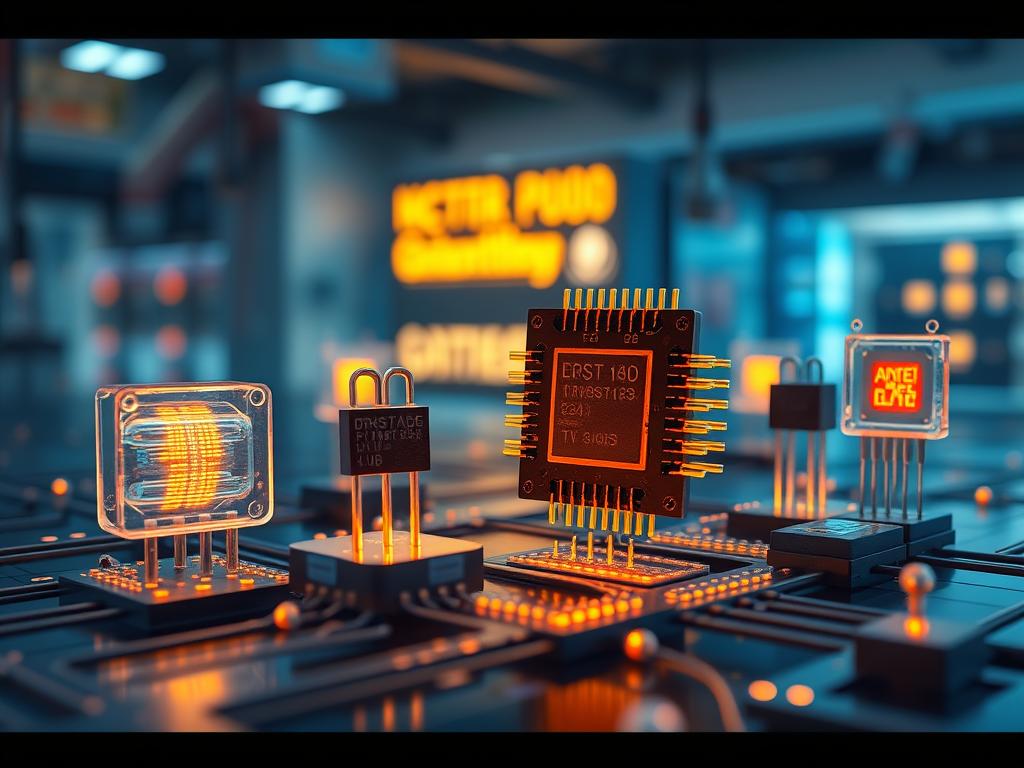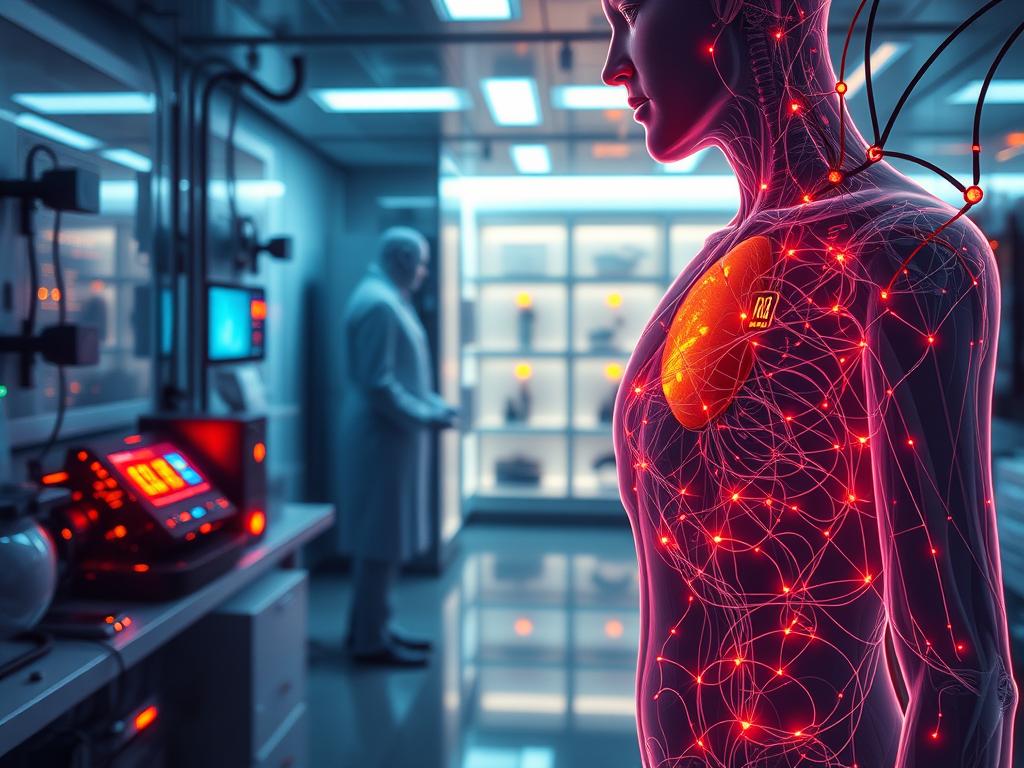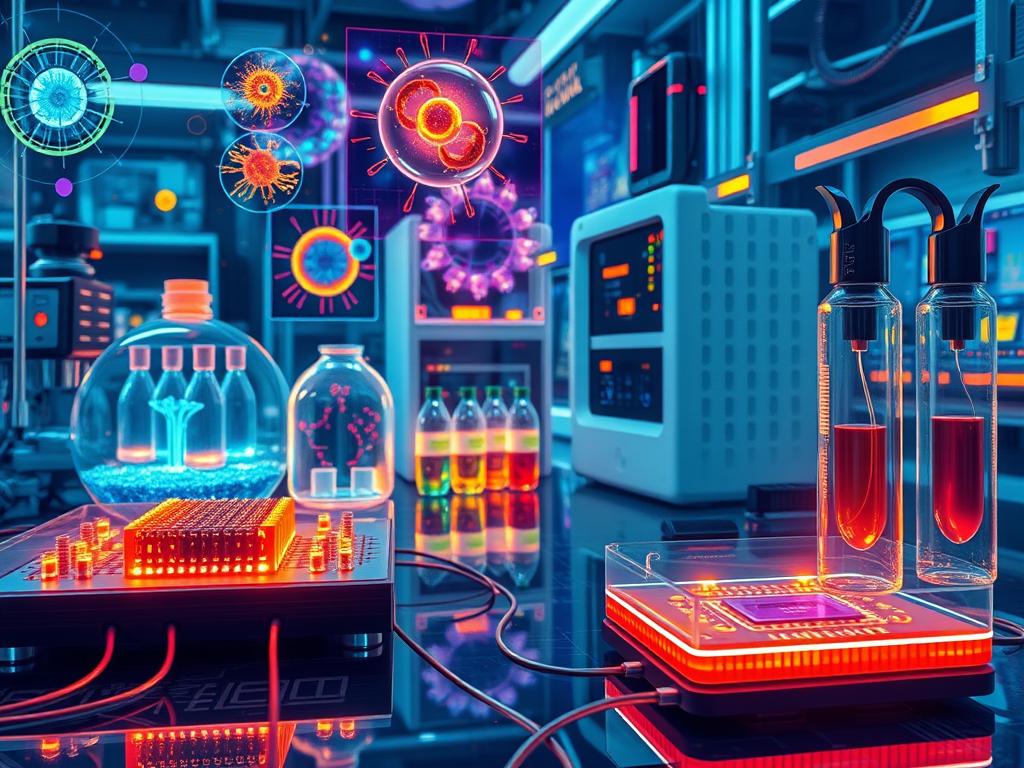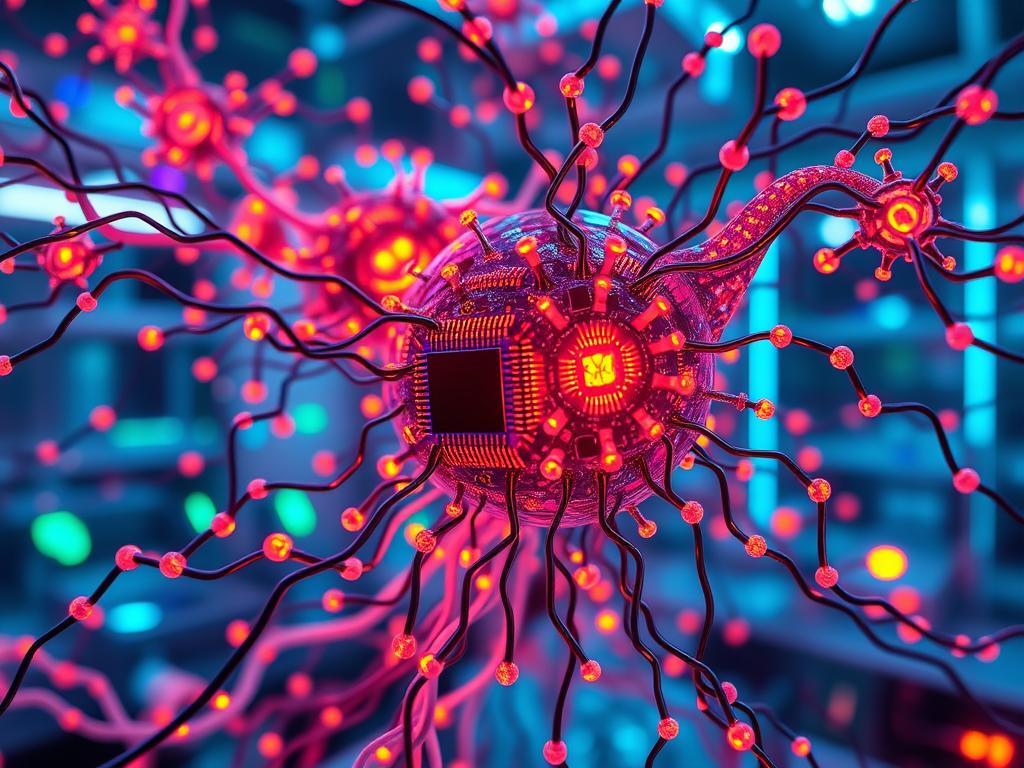Nanobioelectronics combines nanotechnology and transistor technology. It’s a field that could change how we approach biomedical applications. Field-effect transistor biosensors, or Bio-FETs, are a key part of this. They use bio-receptors and ion-sensitive field-effect transistors (ISFETs) to detect biomolecules very accurately.
Nanomaterials like silicon nanowires, carbon nanotubes, and graphene are at the core of these devices. They have high surface areas, are very conductive, and are safe for use in the body. This makes them perfect for working with biological systems.
Scientists have also been working on better bio-probes. These include antibodies, DNA/RNA, aptamers, and peptide nucleic acids. They help make the sensors more specific and sensitive. The use of these advanced materials and bio-recognition elements is a big part of the field’s progress.
Key Takeaways
- Nanobioelectronics combines nanotechnology and transistor technology for innovative biomedical applications.
- Field-effect transistor biosensors (Bio-FETs) integrate bio-receptors with ion-sensitive field-effect transistors (ISFETs) for advanced sensing capabilities.
- Nanomaterials like silicon nanowires, carbon nanotubes, and graphene serve as exceptional transducers in nanobioelectronic devices.
- Researchers have developed advanced bio-probes, including antibodies, DNA/RNA, aptamers, and peptide nucleic acids, to enhance the specificity and sensitivity of these sensors.
- Ongoing efforts focus on improving sensitivity through innovative nanotransducer designs and optimized bio-probe selection.
Introduction to Nanobioelectronics
Nanobioelectronics is a field that mixes nanotechnology and bioelectronics. It’s used for advanced medical uses. This area started with biosensors in the 1960s and now uses nanomaterials and new transistor tech. It combines Biocompatible Electronics, Bioelectronics, and Nanoscale Devices for better healthcare. It helps with precise diagnosis, monitoring, and treatments.
Definition and Scope
Nanobioelectronics brings together many fields like materials science, chemistry, and medicine. It uses nanomaterials for sensitive and specific devices. This field has changed how we tackle medical problems.
Historical Context
The start of nanobioelectronics is in the 1960s with biosensors. Since then, nanomaterials have opened up new possibilities. Now, Biocompatible Electronics, Bioelectronics, and Nanoscale Devices are used in many medical areas.
Importance in Modern Science
Nanobioelectronics is key in today’s healthcare. It’s behind new diagnostic tools, monitoring, and treatments. Thanks to nanomaterials and advanced transistors, we have devices like blood glucose sensors and pacemakers. This field is always finding new ways to improve medicine.
“Nanobioelectronics has the potential to revolutionize the way we approach healthcare, from early disease detection to personalized treatment strategies.”
Fundamentals of Transistors
Transistors are key in modern Transistor Technology. They are vital in Nanoscale Devices and Medical Technology. These devices control electrical current flow, turning biological signals into electrical ones.
What is a Transistor?
A transistor is a semiconductor that acts as an amplifier or switch. It controls electrical current flow. In nanobioelectronics, field-effect transistors (FETs) are often used. This includes silicon nanowire FETs (SiNWFETs) and carbon nanotube FETs (CNTFETs).
Types of Transistors Used in Nanobioelectronics
- Silicon Nanowire FETs (SiNWFETs): These devices are very sensitive for detecting things without labels. They can work in real-time. To make them better, scientists are working on making lots of them at once.
- Carbon Nanotube FETs (CNTFETs): Carbon nanotubes are great for biosensors because they are strong and conduct electricity well. But making them can mix semiconducting and metallic tubes, which can make devices less reliable.
- Graphene FETs: Graphene is very good for FETs because of its electrical properties. But it doesn’t have a band gap, which limits its on/off ratio. Scientists are trying to make graphene FETs more sensitive.
The type of transistor used can affect how well a device works. Scientists are still working to make transistors more sensitive and safe for medical use.
| Transistor Type | Key Characteristics | Potential Applications |
|---|---|---|
| Silicon Nanowire FETs (SiNWFETs) | High sensitivity, label-free detection, potential for mass production | Real-time biomarker monitoring, early disease diagnosis |
| Carbon Nanotube FETs (CNTFETs) | Superior physical and chemical properties, efficient electron-transfer | Highly sensitive biosensors, personalized healthcare |
| Graphene FETs | Extraordinary electrical properties, but limited on/off ratio | Electronic devices, energy storage, and conversion |

“The choice of transistor type is crucial in nanobioelectronics, as it directly affects the device performance and suitability for various Medical Technology applications.”
The Role of Nanotechnology in Biomedical Applications
Nanotechnology has changed the game in biomedical engineering. It lets us create new medical tools at the nanoscale (1-100 nm). This means we can make devices that are more sensitive and effective.
Nanomaterials like nanoparticles and nanofibers are key. They help biomedical devices work better. This is true for many medical uses.
Definition of Nanotechnology
Nanotechnology is about working with materials at the nanoscale. It’s about designing and making things at the atomic and molecular level. This lets us create materials with special properties for medicine.
Innovations in Drug Delivery
Nanotechnology has really improved drug delivery. Nanoparticles and nanofibers can carry drugs better. They can target specific cells and release drugs slowly.
This means drugs work better and have fewer side effects. For example, gold nanoparticles (Au NPs) are used a lot in medicine. They’re easy to make and have special properties.
Quantum dots (QDs) are also important. They’re tiny crystals that glow and help find proteins and bacteria. They’re better than old fluorescent dyes.
“Nanomaterials with at least one dimension smaller than 100 nm can incorporate into cells for biomedical applications like in vitro and in vivo imaging, drug-delivery, and targeting tumor cells.”
Nanotechnology and biomedical engineering together are creating new things. We’re getting better drug delivery, imaging, and biosensors. These could change healthcare a lot.
Applications of Nanobioelectronics in Healthcare
Nanobioelectronics is changing healthcare, making wearable and implantable devices better. These technologies use [Medical Technology], [Nanomedicine], and [Biocompatible Electronics]. They help in monitoring patients, managing diseases, and treating them in a more personal way.
Wearable Health Monitoring Devices
Wearable sensors with nanobioelectronics can track many health signs like heart rate and glucose levels. These devices are small, comfy, and give real-time health data. This lets patients manage their health better.
By using nanomaterials, these sensors are more accurate and reliable. This changes how doctors and patients work together for better health.
Implantable Medical Devices
Nanobioelectronics also improves implantable devices like pacemakers. These devices use tiny parts to work better with the body. They help monitor health, deliver drugs, and treat diseases.
“Nanobioelectronics is paving the way for a future where healthcare is more personalized, proactive, and effective than ever before.”
Nanobioelectronics is set to change healthcare a lot. It will help patients and doctors get better results and improve life quality.

Advances in Transistor Technology
Transistor technology has made huge strides, changing biomedical electronics a lot. Miniaturization, flexibility, and biocompatibility are key. These advancements lead to flexible transistors and biocompatible electronics.
Miniaturization and Flexibility
Transistors have gotten smaller, making devices thin and flexible. These nanoscale devices fit the skin well, making them comfortable. They’re also light and strong, good for health monitors and implants.
Biocompatibility and Safety
It’s important for biomedical electronics to be safe and stable. New surface treatments and materials have helped. These biocompatible electronics reduce the chance of bad reactions, making them safe for use inside the body.
Research keeps improving transistor technology. It aims to make these tiny devices better and safer. This mix of new electronics and materials is changing healthcare and personal health.
| Metric | Improvement | Comparison |
|---|---|---|
| Limit of Detection (LoD) for Nucleic Acids in bioFETs | From ~10 fM in buffer and >10 pM in serum to 17 zM in buffer and 500 zM in serum | Polymerase Chain Reaction (PCR) can detect nucleic acid down to 1 copy per 100 μl, which is equivalent to 17 zM |
| Limit of Detection (LoD) for Proteins in bioFETs | From >1 pM in buffer and serum to ~20 zM in buffer and 250 zM in serum | Enzyme-Linked Immunosorbent Assay (ELISA) can detect proteins down to ~0.1 fM |
| Packing Density of bioFETs | Planar silicon-based bioFETs: >1 million bioFETs per chip Carbon Nanotube (CNT)-based bioFETs: ~10,000 bioFETs per chip Graphene-based bioFETs: From ~10 to 256 bioFETs per chip | Higher packing density is achieved with more mature integrated circuit (IC) technology |
Nanobioelectronics for Disease Diagnostics
Nanobioelectronic devices are changing how we diagnose diseases. They let us watch biomarkers in real time. This helps find diseases early and treat them better. These devices can spot specific proteins and other molecules linked to diseases.
Real-time Monitoring of Biomarkers
Nanoscale sensors in these devices are very sensitive. They can find tiny amounts of disease biomarkers. This means doctors can catch diseases early, leading to better treatments and outcomes.
These devices keep an eye on important biomarkers. This gives doctors the info they need to make quick, smart choices.
Early Detection Systems
Nanobioelectronics use special materials like silicon nanowires and graphene. These materials make super accurate diagnostic tools. These tools can find disease markers that other methods miss.
Early detection is key for treating many diseases well. It’s especially important for cancer and heart diseases.
The mix of Biomedical Engineering, Medical Technology, and Nanomedicine has made these new technologies possible. They’re changing how we diagnose diseases and moving towards more personalized care.

The Future of Transistors in Medicine
The field of Transistor Technology is growing fast. It’s changing Medical Technology and Biomedical Engineering a lot. Researchers are working on new ideas that could change healthcare and how we diagnose diseases.
Trends in Research and Development
One exciting trend is biodegradable electronics. These devices can be used on the body and then break down safely. They don’t need surgery and don’t cause long-term problems.
Another area is combining transistors with AI and ML. This creates tools that can find diseases early and give treatments that fit each person. It also predicts health issues before they start.
Potential Breakthroughs on the Horizon
One big hope is brain-computer interfaces. These use transistors to help people with paralysis or other brain issues. They could make a big difference in how we help people with these conditions.
Also, there’s work on smart drug delivery systems. These devices watch how a patient’s body is doing and adjust the medicine. This could make treatments better and reduce side effects.
Finally, new tools are being made to find diseases early. These use transistors to spot problems before they get bad. This could change how we prevent and treat diseases.
The future of Biomedical Engineering looks bright with Transistor Technology. It could lead to better medicine, finding diseases early, and new treatments. Transistors could really change healthcare for the better.
Impact on Personalized Medicine
Nanobioelectronics is changing personalized medicine. It lets doctors tailor treatments for each patient. This is made possible by Nanomedicine, Medical Technology, and Biomedical Engineering. Nanobioelectronic devices give detailed, real-time data. This helps doctors create personalized plans for better results.
Tailoring Treatments to Individual Patients
Nanobioelectronic devices collect a lot of data. They look at biomarkers, genetics, and how the body reacts. This info lets doctors make treatments that fit each patient’s needs.
Personalized therapies lead to better results. Patients see fewer side effects and better control over their health.
Role of Data Analytics in Treatment Optimization
The data from nanobioelectronic devices is analyzed with advanced tools. Data analytics and machine learning find patterns and predict outcomes. This helps doctors make better choices.
Using data analytics makes personalized medicine more precise. It leads to better health for patients.
“Nanobioelectronics is not just about the devices themselves, but about the transformative impact they can have on healthcare and the way we approach personalized medicine.”

Nanobioelectronics is bringing a new era to healthcare. It combines Nanomedicine, Medical Technology, and Biomedical Engineering. This means treatments are made just for each patient.
With nanobioelectronics, doctors can give better care. This improves patient outcomes and quality of life.
Cost-effectiveness of Nanobioelectronics
The fields of Medical Technology, Biomedical Engineering, and Nanomedicine are growing fast. This growth shows the promise of cheaper healthcare through nanobioelectronic devices. Even though these devices cost a lot to make at first, they can save a lot of money in the long run.
Nanobioelectronic devices can find diseases early and treat them better. They use tiny sensors to spot biomarkers and health signs with great accuracy. This leads to better care, fewer hospital stays, and lower treatment costs.
Affordable Healthcare Solutions
Experts and makers are working hard to make these devices cheaper and more available. They’re improving how they make these devices and buying them in bigger numbers. This will lower the cost, making them a good choice for both healthcare systems and patients.
Economic Impact on the Medical Industry
Nanobioelectronics will change the medical world a lot. It will create new markets for tiny medical devices. This will give chances for new businesses and big companies to make innovative products. It could also make healthcare more efficient, saving money and improving care.
As Medical Technology, Biomedical Engineering, and Nanomedicine keep growing, the value of nanobioelectronic devices is clear. These advanced tools can help make healthcare cheaper and more effective. This could change the medical world a lot.
| Key Advantages of Nanobioelectronic Devices | Potential Economic Benefits |
|---|---|
|
|
The progress in nanowire field-effect transistors (NW-FETs) and other nanobioelectronic tech is big. It’s making healthcare cheaper and more accessible. It’s changing how doctors diagnose, watch, and treat patients.
“The integration of nanobioelectronics into the medical industry is poised to have a significant economic impact, opening up new markets and opportunities for innovation.”
Challenges in Nanobioelectronics
The field of nanobioelectronics is growing fast. But, it faces many technical, regulatory, and ethical hurdles. These challenges must be tackled to fully use Biocompatible Electronics, Nanoscale Devices, and Medical Technology.
Technical Barriers
One big challenge is keeping devices stable and reliable in the body. It’s important to keep signals clear and reduce noise. Even small changes can affect how well Nanoscale Devices work.
Also, making more of these Biocompatible Electronics without losing quality is hard. It’s a big problem to solve.
Regulatory and Ethical Considerations
Getting approval for new Medical Technology is tough. The FDA demands lots of tests and paperwork to prove safety and effectiveness. This is a big task.
There are also ethical issues. For example, privacy when monitoring health all the time. And the risks of devices staying in the body for a long time.
| Technical Challenges | Regulatory and Ethical Challenges |
|---|---|
|
|
Despite the hurdles, Nanobioelectronics could change healthcare a lot. It’s key to work together to solve these problems. This way, we can unlock the full potential of this technology.

Collaborative Efforts in Research
The field of nanobioelectronics grows thanks to teamwork between universities, research centers, and companies. Schools focus on basic science and new ideas. Companies help turn these ideas into real products.
Universities and Research Institutions
Universities and research centers lead in nanobioelectronics research. They explore new ideas and materials. They have the tools, knowledge, and money needed for big discoveries.
By working together across different fields like Biomedical Engineering, Nanotechnology, and Medical Technology, researchers unlock nanobioelectronics’ full potential for health.
Industry Partnerships
Working together, schools and companies make nanobioelectronics research real. Companies know how to make products, follow rules, and make lots of them. This helps new ideas get to people who need them.
Working together worldwide is also key. Researchers from everywhere help solve big health problems. They share knowledge and ideas to make medical technology better faster.
Working together is key for nanobioelectronics to keep growing. Schools, research centers, and companies use their strengths to make new discoveries. This leads to better health care for everyone.
Case Studies of Successful Applications
Nanobioelectronics have led to big changes in medicine, especially in fighting cancer and managing diabetes. These new technologies use tiny electronics to send treatments directly to the right places. They also help doctors keep a closer eye on patients, showing how Nanomedicine, Medical Technology, and Biomedical Engineering are making a difference.
Examples in Cancer Treatment
Nanobioelectronic systems have changed cancer treatment for the better. They use tiny particles to carry drugs right to tumors, reducing harm to healthy cells. This technology can spot cancer markers at very low levels, helping doctors catch and treat cancer early.
For example, scientists have found cancer in tiny amounts, like one to ten copies in 100 μl of fluid. These sensors can also find SARS-CoV-2 RNA fast, without needing to extract RNA or amplify it. This shows their power in quick and accurate disease testing.
Impact on Diabetes Management
Nanobioelectronics have also changed how we manage diabetes. They use tiny transistors for continuous glucose monitoring, helping patients control their blood sugar better. These devices can spot glucose levels as low as 10-17 M, giving patients and doctors the info they need to improve treatment plans.
Also, new biosensors can find tiny amounts of biomarkers, like proteins and DNA, very accurately. These advances could change how we manage diabetes and many other diseases.
“The integration of nanobioelectronics has revolutionized the management of diabetes, providing patients with real-time data to help optimize treatment strategies.”
These examples show how nanobioelectronics are changing healthcare. They offer new ways to treat diseases and improve life for people with complex health issues.
Educational Programs and Resources
The fields of Biomedical Engineering, Nanotechnology, and Medical Technology are changing fast. Educational programs and resources are popping up to train the next scientists and engineers. Universities worldwide are creating special courses that mix nanotechnology, bioengineering, and electronics.
These courses give students the skills and knowledge to face the challenges in nanobioelectronics. It’s a field that’s growing fast.
Training the Next Generation of Scientists
Top schools are starting new educational projects. They aim to connect theory with practice. Now, students can get degrees like Master’s in Nanobioelectronics or Ph.D. in Bioelectronics.
These programs include lab work, research projects, and teamwork. They help students see how nanobioelectronics can change the world.
Online Courses and Workshops
Online courses and workshops are also becoming popular. They make learning about nanobioelectronics easy for everyone. You can learn about nanowire field-effect transistors in biomedical applications and more.
These online resources help people from all over learn together. They’re key to growing the field and inspiring new innovators.
“The field of nanoelectronics shows promise in transforming lives, especially in bioelectronics and bio-inspired electronics applications, over the next 5 to 10 years.”
As more people need to know about nanobioelectronics, these programs will be crucial. They’ll help shape the future of this field. This will lead to better healthcare, personalized medicine, and overall well-being for everyone.
Regulatory Framework Surrounding Nanobioelectronics
The field of nanobioelectronics is growing fast. So is the regulatory framework around it. The U.S. Food and Drug Administration (FDA) has set up detailed guidelines. These are for nanomedicine and biocompatible electronics in medical use.
FDA Guidelines and Approvals
The FDA looks at several important things for nanobioelectronic devices. They check the materials, how they interact with the body, and any possible harm. Before they can be sold, devices must meet high safety and performance standards.
Global Regulatory Perspectives
Worldwide, groups are working to make rules for nanobioelectronic devices the same. This helps keep patients safe and encourages new ideas in Medical Technology. Agencies around the world are making rules. They aim to protect health while allowing for Biocompatible Electronics to grow.
| Nanomaterial Characteristic | Typical Range |
|---|---|
| Nanowire Diameter | 3 to 500 nm |
| Nanowire Length | Several hundred nm to millimeters |
| Transconductance (SiNWs) | 0.5-5 μS V−1 |
| Transconductance (CNTs) | 0.5-1 μS V−1 |
| Transconductance (Graphene) | 100-500 μS V−1 |
The rules for Nanomedicine and Biocompatible Electronics are changing. They aim to support new ideas while keeping patients safe. As nanobioelectronics gets more advanced, rules are being updated to match.
Public Perception and Acceptance
The field of Nanomedicine and Medical Technology is growing fast. It’s important to understand how the public sees Biocompatible Electronics. Educational efforts help explain the good and bad sides of these new technologies. This builds trust and encourages smart talks.
Educating the Public
Nanobioelectronics, like advanced biosensors and implantable devices, could change healthcare a lot. But, people might worry about their safety, privacy, and long-term effects. It’s key to talk openly and teach the public about these technologies.
- Start public awareness campaigns to show how nanobioelectronics can help patients and improve life quality.
- Host workshops and seminars to teach people about the latest in nanobioelectronics and how safe they are.
- Work with healthcare providers and patient groups to share info and answer local concerns.
Addressing Concerns and Misconceptions
People worry about privacy, side effects, and long-term effects of nanobioelectronics. We need to talk about these worries openly and with facts. This way, people can make smart choices and trust these new technologies more.
- Make sure there are clear rules to keep patient data safe and private.
- Do lots of tests and trials to show that nanobioelectronic devices are safe and work well.
- Have open talks and work together on research to clear up misunderstandings and worries.
By teaching the public and tackling their worries, Nanomedicine and Medical Technology can get more support. This will lead to better healthcare and a better life for patients.
Conclusion
Nanobioelectronics is a new field that combines nanotechnology, biology, and electronics. It brings new ways to diagnose, treat, and monitor health. This could change how we get medical care and make it more personal.
The goal is to create devices that work well with our bodies. These devices will help us in big ways, making healthcare better and more tailored to each person.
Summary of Key Points
Nanobioelectronics uses special materials like silicon nanowires and graphene. These materials help make biosensors that can detect tiny changes in our bodies. This is key for catching diseases early and improving healthcare.
These biosensors can watch biomarkers in real-time. This means doctors can spot problems sooner. It also helps in making healthcare more personal and effective.
The Vision for Future Developments in Nanobioelectronics
More research and teamwork are needed to move forward in nanobioelectronics. As we learn more, we’ll see devices that work well with our bodies. This could change healthcare a lot.
These devices could make healthcare better and more personal. The future of nanobioelectronics is very promising. It could change how we deal with diseases and health issues.


